Click here to skip ahead to the Honorable Mention list.
Click here to skip ahead to the start of the Top 20 list.
Click here to skip ahead to the Comments.
The idea came to us in passing: let’s chronicle a decade’s worth of pop and rock music — from 2000 through 2009 — recorded by folks living in Champaign-Urbana. After we thought on it for a few days the concept had taken root. We have access to the community who created the music and they could certainly help us shape such a best-of list. And we are in touch with some of the town’s most knowledgeable music critics; they could help us find the right words. Together, we could create “The List” and give the past decade of local music its due props.
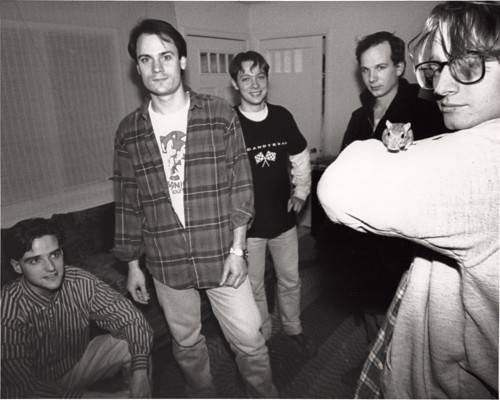 Champaign-Urbana’s musical community loves to fondly recall its 1990s music scene as the glory days, sometimes while negating the impact of this decade. There is certainly a lot to love about the C-U scene in the ’90s, even if nowadays we can barely recall how hard Honcho Overload partied back in the day (pictured on right in 1993; sorry, but the photo of Bill Johnson on stage wearing a 27-pound pumpkin on his head as a “mummified” Matt Talbott plays bass while standing on 2-foot-high painters’ stilts is sadly MIA). Plenty of local bands were garnering significant national attention in the 1990s and a few dedicated live music venues both on and off campus were hosting memorable rock bills with regularity. A few additional developments galvanized the scene: the creation of the Great Cover Up, alt-weekly The Octopus, radio station 93.5 “The Web,” Parasol Records, Hammerhead Records, and (in nearby Danville) Polyvinyl Records. At one point in the mid 1990s there were no fewer than five local bands simultaneously signed to major labels, and if you toss in the round that came before them in the early ’90s, nine C-U bands were signed to majors during the decade. Nine. Chalk that up to the quality and depth of the scene, but also to the fact that the national indie scene had successfully crossed over to the mainstream due to a confluence of factors that boosted the confidence of recording industry execs. The C-U scene caught a wave at the right time and several superb bands rode it in.
Champaign-Urbana’s musical community loves to fondly recall its 1990s music scene as the glory days, sometimes while negating the impact of this decade. There is certainly a lot to love about the C-U scene in the ’90s, even if nowadays we can barely recall how hard Honcho Overload partied back in the day (pictured on right in 1993; sorry, but the photo of Bill Johnson on stage wearing a 27-pound pumpkin on his head as a “mummified” Matt Talbott plays bass while standing on 2-foot-high painters’ stilts is sadly MIA). Plenty of local bands were garnering significant national attention in the 1990s and a few dedicated live music venues both on and off campus were hosting memorable rock bills with regularity. A few additional developments galvanized the scene: the creation of the Great Cover Up, alt-weekly The Octopus, radio station 93.5 “The Web,” Parasol Records, Hammerhead Records, and (in nearby Danville) Polyvinyl Records. At one point in the mid 1990s there were no fewer than five local bands simultaneously signed to major labels, and if you toss in the round that came before them in the early ’90s, nine C-U bands were signed to majors during the decade. Nine. Chalk that up to the quality and depth of the scene, but also to the fact that the national indie scene had successfully crossed over to the mainstream due to a confluence of factors that boosted the confidence of recording industry execs. The C-U scene caught a wave at the right time and several superb bands rode it in.
The decade of the 2000s brought with it, by contrast, a much more conservative climate in the music industry. The Midwest’s rock and roll bubble had finally burst. Not only were major labels shying away from real rock and roll bands in favor of the teen pop formula that had served them well over the years, but the nation’s fascination with the rock and roll scenes in locales like Minneapolis, Chicago, and C-U was severely waning, if not wholly absent. The upper East Coast was once again the place to be. The forecast for C-U bands hoping to spend time in the national spotlight post Y2K was decidedly overcast. Some might say, “sour grapes.” So be it. But you can’t fault the bands of the aughts for fighting to overcome the odds and develop their own collective identity, just as you can’t overlook the impact of the ’90s scene on the decade that followed. (The remnants of many of those great ’90s bands ended up on The List.)
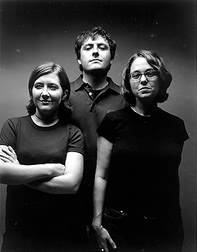 As the 1990s came to a close, we saw the dissolution of some of C-U’s cherished acts, namely Braid, Hum, Castor, and Sarge (pictured left). One exceptional band, Poster Children, continued to carry the torch (albeit with less urgency), as did a handful of other veteran rock outfits — National Skyline, The Mezzanines, The Signalmen, Tummler, Wolfie, and Absinthe Blind. Yet, as the 2000s got underway there were reasons for higher hopes for a return to form. Several pieces of the puzzle were falling in place: C-U boasted a new downtown Champaign venue, The Highdive, that had everyone talking about its aesthetic appeal and its impressive recruitment of touring bands; The Octopus was rebranded under new ownership as CU Cityview, and its music section was beginning to hit its stride with the hosting of a local music showcase on a Monday night in November that nearly packed The Highdive; Polyvinyl officially relocated from Danville to Champaign, shed its regional emo tag, and quickly grew by leaps and bounds into a formidable national indie; and a magazine-slash-label, Innocent Words, sprung up to provide additional perspective. Meanwhile, Parasol and its subsidiary labels, when not breaking Scandinavian bands in the States, continued to release a slew of interesting albums by local artists.
As the 1990s came to a close, we saw the dissolution of some of C-U’s cherished acts, namely Braid, Hum, Castor, and Sarge (pictured left). One exceptional band, Poster Children, continued to carry the torch (albeit with less urgency), as did a handful of other veteran rock outfits — National Skyline, The Mezzanines, The Signalmen, Tummler, Wolfie, and Absinthe Blind. Yet, as the 2000s got underway there were reasons for higher hopes for a return to form. Several pieces of the puzzle were falling in place: C-U boasted a new downtown Champaign venue, The Highdive, that had everyone talking about its aesthetic appeal and its impressive recruitment of touring bands; The Octopus was rebranded under new ownership as CU Cityview, and its music section was beginning to hit its stride with the hosting of a local music showcase on a Monday night in November that nearly packed The Highdive; Polyvinyl officially relocated from Danville to Champaign, shed its regional emo tag, and quickly grew by leaps and bounds into a formidable national indie; and a magazine-slash-label, Innocent Words, sprung up to provide additional perspective. Meanwhile, Parasol and its subsidiary labels, when not breaking Scandinavian bands in the States, continued to release a slew of interesting albums by local artists.
A new batch of baby-faced bands emerged and great expectations were heaped on their shoulders. They would be asked to walk out of the shadow of the 1990s and carve their own identity. C-U music fans welcomed into their vernacular several bands on the rise: The Beauty Shop, The Blackouts, Rectangle, Imaginary Posse, Everybody Uh Oh, and Tractor Kings. And some old faces reemerged to dazzle again in forms familiar (Adam Schmitt, Menthol, Brendan Gamble, Lanterna, Angie Heaton) and unfamiliar (Centaur, Glifted, Temple of Low Men).
 More notable bands and singer-songwriters joined (or rejoined) the fold as the decade progressed: Terminus Victor, Lorenzo Goetz, Darrin Drda, Rob McColley, The Greedy Loves, Paul Kotheimer, Emotional Rec Club, Mad Science Fair, Solips, The Invisible, Headlights, At Knifepoint, Triple Whip, I:Scintilla, Elsinore, Kate Hathaway, The Chemicals, JigGsaw, Shipwreck, New Ruins, Curb Service, Santa (pictured right; photo by Abby Toms), Casados, and Common Loon. Only one of them would be signed to a major: a band that called C-U home but for a relatively brief window of time, American Minor. Just a few more were signed to reputable indies. To some, this lack of regional and national notoriety meant the scene was languishing, but many could agree that C-U was still very much alive and kicking, if out of the spotlight. Count those of us at Smile Politely in that latter group. We note the diversity of the scene during this decade as a calling card that it was indeed mutating and maturing. On one hand you had a band like Water Between Continents pursuing abstract, improvisational concepts, while on the other The Buzzards were imagining Gram Parsons as doo-wop Americana. If you had a mutant third hand, you’d find The Greedy Loves stomping on it, perfecting their love for all things Chris Stamey, Mitch Easter, and Paul Westerberg.
More notable bands and singer-songwriters joined (or rejoined) the fold as the decade progressed: Terminus Victor, Lorenzo Goetz, Darrin Drda, Rob McColley, The Greedy Loves, Paul Kotheimer, Emotional Rec Club, Mad Science Fair, Solips, The Invisible, Headlights, At Knifepoint, Triple Whip, I:Scintilla, Elsinore, Kate Hathaway, The Chemicals, JigGsaw, Shipwreck, New Ruins, Curb Service, Santa (pictured right; photo by Abby Toms), Casados, and Common Loon. Only one of them would be signed to a major: a band that called C-U home but for a relatively brief window of time, American Minor. Just a few more were signed to reputable indies. To some, this lack of regional and national notoriety meant the scene was languishing, but many could agree that C-U was still very much alive and kicking, if out of the spotlight. Count those of us at Smile Politely in that latter group. We note the diversity of the scene during this decade as a calling card that it was indeed mutating and maturing. On one hand you had a band like Water Between Continents pursuing abstract, improvisational concepts, while on the other The Buzzards were imagining Gram Parsons as doo-wop Americana. If you had a mutant third hand, you’d find The Greedy Loves stomping on it, perfecting their love for all things Chris Stamey, Mitch Easter, and Paul Westerberg.
We decided to tackle the documentation of a decade’s worth of C-U music largely because we love two things dearly: lists and local bands. For those of you who lived this decade, even in part, we think you’ll find plenty to celebrate in the following overview. As we began polling folks on their favorite local records of the past ten years, we noticed a theme developing: “Hey, I’ve been to so many shows and I’ve seen so many of these bands play live, but I haven’t heard a lot of their recorded music.” Well, here’s your excuse to revisit and relive the recorded side of some of our best musicians. And for those newbies to the scene, we hope The List serves as an ample introduction to what made the 2000s a fun decade to be a fan of local music.
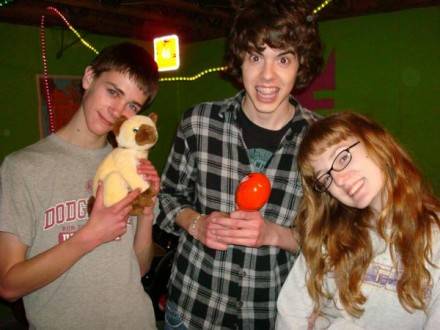 The method to our madness is entirely subjective. First, we asked a certain local music historian and radio DJ who everyone knows, Todd Hunter, to develop a laundry list of (nearly) every local rock and pop release from 2000 to the present (e.g., actively promoted albums, whether self-released or put out by a label, from bands who were living in C-U). Then, we shared that list with others, polling those who had spent a good chunk of change in venues during the past decade: musicians, of course, but also promoters, DJs, journalists, photographers, record label types, and passionate fans, too. We asked them to provide us with ordered Top 10 lists of their favorite records; then we compiled an aggregate list from their responses. (They came through with more than 100 unique album nominations, touching upon nearly every niche in the scene, from Kilborn Alley and Zea Mays all the way to The Violents and The Jips, pictured above. A big THANK YOU to those who participated in our polling.) We relied on their lists to help shape The List (along with several honorable mentions, albums that received votes but just missed our cut). We took some liberty with the community’s collective list as we saw fit. But thanks to the community’s input, we were able to form an educated, informed guide to the past decade of local music. And we think it broadly supports their opinions.
The method to our madness is entirely subjective. First, we asked a certain local music historian and radio DJ who everyone knows, Todd Hunter, to develop a laundry list of (nearly) every local rock and pop release from 2000 to the present (e.g., actively promoted albums, whether self-released or put out by a label, from bands who were living in C-U). Then, we shared that list with others, polling those who had spent a good chunk of change in venues during the past decade: musicians, of course, but also promoters, DJs, journalists, photographers, record label types, and passionate fans, too. We asked them to provide us with ordered Top 10 lists of their favorite records; then we compiled an aggregate list from their responses. (They came through with more than 100 unique album nominations, touching upon nearly every niche in the scene, from Kilborn Alley and Zea Mays all the way to The Violents and The Jips, pictured above. A big THANK YOU to those who participated in our polling.) We relied on their lists to help shape The List (along with several honorable mentions, albums that received votes but just missed our cut). We took some liberty with the community’s collective list as we saw fit. But thanks to the community’s input, we were able to form an educated, informed guide to the past decade of local music. And we think it broadly supports their opinions.
There’s plenty to argue about herein, so go ahead and pick a fight. Right away, you’ll notice that we excluded, with apologies, many genres (jazz, classical, blues, choral, Oceanic folk, Baile funk, yé-yé, cha-cha-chá, space-age bachelor pad music, Klezmer, Volksmusik, Tuvan throat singing, etc.) — not because we’re indie rock snobs, but because we could only tackle so much (rock, pop, hip hop, folk) at one time. (However, at least a couple artists on our list would likely indulge you by attempting any of the aforementioned styles.) DJ compilations, like dLo and Spinnerty’s standout 2003 mixtape, Play It on the Porch, are also precluded from The List for the same reason.
We hope you’ll enjoy reading about the selections and listening to the music. We encourage you to please support these artists by purchasing their music at your friendly C-U brick and mortar record store of choice. But do keep in mind: the scene is much bigger than any simple list — even The List. This is just one publication’s take on ten years of local pop and rock music. We think its definitive, of course. However, you can and should plunge into deeper waters. So consider this article your diving board from which to cannonball. –DOUG HOEPKER
* * *
We’ll start with those records that barely missed inclusion on The List.
Honorable Mention (in alphabetical order)
American Minor
Buffalo Creek
(Jive, 2004)
Listen to “Walk On” by American Minor
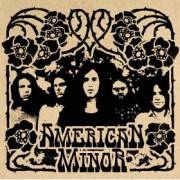 Chock-full of Southern rock stomp, American Minor’s Buffalo Creek E.P. is the perfect sampling of the hard-working West Virginia band that C-U welcomed with open arms, marked notably by the title track’s roaring guitars. Around this time, American Minor was seen as the band whose promise outside of C-U seemed imminent, but with that imminence came change. Unfortunately, the band’s subsequent self-titled debut — the only local, major-label full-length release of the decade — adopted a more polished sound. The absence of that long-player on this list suggests two things: the record’s forgettable nature and the band’s ultimate breakup. –ZACK ADCOCK
Chock-full of Southern rock stomp, American Minor’s Buffalo Creek E.P. is the perfect sampling of the hard-working West Virginia band that C-U welcomed with open arms, marked notably by the title track’s roaring guitars. Around this time, American Minor was seen as the band whose promise outside of C-U seemed imminent, but with that imminence came change. Unfortunately, the band’s subsequent self-titled debut — the only local, major-label full-length release of the decade — adopted a more polished sound. The absence of that long-player on this list suggests two things: the record’s forgettable nature and the band’s ultimate breakup. –ZACK ADCOCK
The Beauty Shop
Yr Money or Yr Life
(Mud, 2000)
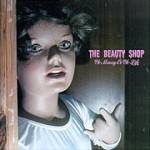 Some unsettling details concerning The Beauty Shop’s debut: the lifelike baby doll flashing the satanic salute on the album’s cover, thoughts of John Hoeffleur writing “fuck” on all his clothes, and the collection of bleak, at times ruthless, Americana songs that make The Handsome Family sound like The Partridge Family. But alongside the vitriol of the title track and dreary ballads like “Science Lights” (still my favorite Beauty Shop song), you also get a host of upbeat acoustic pop songs like “Bloody Nose,” “Dutch Courage,” and “Caramel Apple.” Yr Money is one impressive debut. –DOUG HOEPKER
Some unsettling details concerning The Beauty Shop’s debut: the lifelike baby doll flashing the satanic salute on the album’s cover, thoughts of John Hoeffleur writing “fuck” on all his clothes, and the collection of bleak, at times ruthless, Americana songs that make The Handsome Family sound like The Partridge Family. But alongside the vitriol of the title track and dreary ballads like “Science Lights” (still my favorite Beauty Shop song), you also get a host of upbeat acoustic pop songs like “Bloody Nose,” “Dutch Courage,” and “Caramel Apple.” Yr Money is one impressive debut. –DOUG HOEPKER
DMS
DMS
(Arborvitae, 2000)
Listen to “Laughing With Me” by DMS
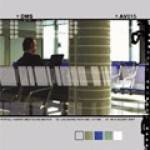 Maybe the strangest, most distinctive local record you’ve never heard? DMS, aka Steve Lamos (drummer for American Football and The Buzzards), played “real-time drums,” “some-times trumpet” and handled all programming on this record, which could best be described as a spastic fusion of Brian Eno, ’70s-era Miles Davis, and Squarepusher — a local precursor to the likes of Dan Deacon. Even more brilliant than this record: watching Lamos pull this all off live — by his lonesome. –DOUG HOEPKER
Maybe the strangest, most distinctive local record you’ve never heard? DMS, aka Steve Lamos (drummer for American Football and The Buzzards), played “real-time drums,” “some-times trumpet” and handled all programming on this record, which could best be described as a spastic fusion of Brian Eno, ’70s-era Miles Davis, and Squarepusher — a local precursor to the likes of Dan Deacon. Even more brilliant than this record: watching Lamos pull this all off live — by his lonesome. –DOUG HOEPKER
Everybody Uh Oh
Man Am I Brad
(Arborvitae, 2002)
Listen to “Champaign’s Too Bright” by Everybody Uh Oh
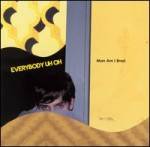 Jeremy Keller was a one-of-a-kind dude: a chubby white guy with a big, curly fro who was more likely to be stoned and watching a Bulls game than working the scene for a leg up (a point that couldn’t be better illustrated than on the droll roll of the eyes that is “Champaign’s Too Bright.”) His songs revealed a range of indie rock influences — Smashing Pumpkins, Yo La Tengo, and the Elephant 6 collective — which he and his bandmates worked into a tuneful yet peculiar, messy sludge on Brad, their sophomore release. –DOUG HOEPKER
Jeremy Keller was a one-of-a-kind dude: a chubby white guy with a big, curly fro who was more likely to be stoned and watching a Bulls game than working the scene for a leg up (a point that couldn’t be better illustrated than on the droll roll of the eyes that is “Champaign’s Too Bright.”) His songs revealed a range of indie rock influences — Smashing Pumpkins, Yo La Tengo, and the Elephant 6 collective — which he and his bandmates worked into a tuneful yet peculiar, messy sludge on Brad, their sophomore release. –DOUG HOEPKER
Brendan Gamble
Heartless Moon
(Mud, 2002)
Listen to “Looking for Margrett” by Brendan Gamble
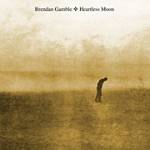 The former Moon Seven Times and Poster Children drummer recorded this largely acoustic album in the wake of his divorce from Lynn Canfield, a set of circumstances that certainly explains the record’s dour, heartbreaking tone. Drummers are jokingly pigeonholed as the dumb ones who always want the band to try out one of their songs; here, Gamble lays waste to that cliché by showcasing considerable skill as both guitarist and songwriter. –DOUG HOEPKER
The former Moon Seven Times and Poster Children drummer recorded this largely acoustic album in the wake of his divorce from Lynn Canfield, a set of circumstances that certainly explains the record’s dour, heartbreaking tone. Drummers are jokingly pigeonholed as the dumb ones who always want the band to try out one of their songs; here, Gamble lays waste to that cliché by showcasing considerable skill as both guitarist and songwriter. –DOUG HOEPKER
Gazelle
Sunblown
(Hidden Agenda, 2008)
Listen to “The First Rays” by Gazelle
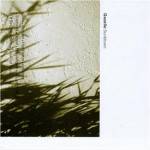 Jeff Dimpsey’s history in the C-U scene dates back to the late ’80s; Adam Fein’s traces to the mid ’90s. So when you add Dimpsey (Hum, Honcho Overload, National Skyline) to Fein (Absinthe Blind), you’re talking about a studied musical vocabulary. Gazelle meshes the best parts of Absinthe Blind’s silvery shoegaze with the propulsive low end and electronic flourishes of National Skyline. Given the talent of this twosome, the results are predictably engaging. –DOUG HOEPKER
Jeff Dimpsey’s history in the C-U scene dates back to the late ’80s; Adam Fein’s traces to the mid ’90s. So when you add Dimpsey (Hum, Honcho Overload, National Skyline) to Fein (Absinthe Blind), you’re talking about a studied musical vocabulary. Gazelle meshes the best parts of Absinthe Blind’s silvery shoegaze with the propulsive low end and electronic flourishes of National Skyline. Given the talent of this twosome, the results are predictably engaging. –DOUG HOEPKER
Hathaways
Hand Me Down
(Self-Released, 2009)
Listen to “Experiment” by Hathaways
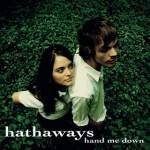 The sibling’s debut may stick out because of Kate Hathaway’s beautiful charango playing, but the too-brief E.P. makes a lasting impression because of the striking way Kate and her brother, James, create haunting, complex vocal melodies to contrast the sparsely and simply arranged songs. Hand Me Down sounds so sincere and natural it’s hard to imagine growing tired of it. –BRIAN McGOVERN
The sibling’s debut may stick out because of Kate Hathaway’s beautiful charango playing, but the too-brief E.P. makes a lasting impression because of the striking way Kate and her brother, James, create haunting, complex vocal melodies to contrast the sparsely and simply arranged songs. Hand Me Down sounds so sincere and natural it’s hard to imagine growing tired of it. –BRIAN McGOVERN
Headlights
Enemies / Kill Them With Kindness
(Polyvinyl, 2004 / Polyvinyl, 2006)
Listen to “TV” by Headlights
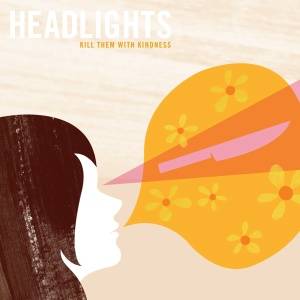 The two earliest official entries in the Headlights’ catalog mark the band blowing off the gates from which it came; the Enemies E.P. debuted the band’s hazy, dreamy pop that would become more fully realized on the debut full-length, Kill Them With Kindness. The latter is stunning in its breadth and frankness, particularly for a debut (though Tristan, Brett, and Erin had been playing together for a year in Absinthe Blind), and earned the band a national following. –ZACK ADCOCK
The two earliest official entries in the Headlights’ catalog mark the band blowing off the gates from which it came; the Enemies E.P. debuted the band’s hazy, dreamy pop that would become more fully realized on the debut full-length, Kill Them With Kindness. The latter is stunning in its breadth and frankness, particularly for a debut (though Tristan, Brett, and Erin had been playing together for a year in Absinthe Blind), and earned the band a national following. –ZACK ADCOCK
Angie Heaton
Let it Ride
(Parasol, 2002)
Listen to “Let It Ride” by Angie Heaton
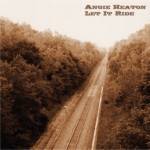 Many people new to the C-U scene don’t know Angie Heaton as a former member of Corndolly and Liquorette (the latter band featured a young Matthew Friedberger). Nor do they know Angie Heaton as a solo artist, which she’s been for more than a decade. Instead, they get to know Angie as the super friendly, smiling face that will often greet them as they walk through the door at Parasol Records. Here’s hoping that changes, as Angie Heaton, solo artist, can write a pretty catchy, emotive pop song when the mood strikes, as evidenced by the title track, which channels her aforementioned musical roots to great effect. –DOUG HOEPKER
Many people new to the C-U scene don’t know Angie Heaton as a former member of Corndolly and Liquorette (the latter band featured a young Matthew Friedberger). Nor do they know Angie Heaton as a solo artist, which she’s been for more than a decade. Instead, they get to know Angie as the super friendly, smiling face that will often greet them as they walk through the door at Parasol Records. Here’s hoping that changes, as Angie Heaton, solo artist, can write a pretty catchy, emotive pop song when the mood strikes, as evidenced by the title track, which channels her aforementioned musical roots to great effect. –DOUG HOEPKER
Paul Kotheimer
Serious Folking Music
(Handmade Records, 2002)
Listen to “Mannequins for Satterthwaite” by Paul Kotheimer
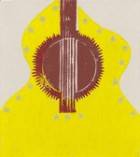 Paul Kotheimer writes folk songs, as in songs by the people and for the people, in this case performed on an acoustic guitar. Political pro-union songs, songs with a blood line that were borrowed from history, songs fighting for a cause; the sort of songs that would make Woody Guthrie, The Weavers, and Phil Ochs proud. But don’t expect these songs to adhere to scare tactics, for Kotheimer also has a sense of humor. Just ask former Urbana mayor Tod Satterthwaite. –DOUG HOEPKER
Paul Kotheimer writes folk songs, as in songs by the people and for the people, in this case performed on an acoustic guitar. Political pro-union songs, songs with a blood line that were borrowed from history, songs fighting for a cause; the sort of songs that would make Woody Guthrie, The Weavers, and Phil Ochs proud. But don’t expect these songs to adhere to scare tactics, for Kotheimer also has a sense of humor. Just ask former Urbana mayor Tod Satterthwaite. –DOUG HOEPKER
Lanterna
Sands
(Badman, 2002)
Listen to “Early August” by Lanterna
 The local post-rock kids were certainly hungry for something when Lanterna’s Sands dropped in 2002, though perhaps not for something so 4AD, so limpid and calm and sexily desolate — a straight-up audio proxy for the barren landscapes that often graced the group’s album covers. But guitarist Henry Frayne’s shimmer denied easy rejection and Sands, with its graceful backbeats and CinemaScopic slow dives, seduced even those looking for Mogwai melodrama in its dreamy fugues. –JOSEPH MARTIN
The local post-rock kids were certainly hungry for something when Lanterna’s Sands dropped in 2002, though perhaps not for something so 4AD, so limpid and calm and sexily desolate — a straight-up audio proxy for the barren landscapes that often graced the group’s album covers. But guitarist Henry Frayne’s shimmer denied easy rejection and Sands, with its graceful backbeats and CinemaScopic slow dives, seduced even those looking for Mogwai melodrama in its dreamy fugues. –JOSEPH MARTIN
The Living Blue
Fire, Blood, Water
(Minty Fresh, 2005)
Listen to “Tell Me Leza” by The Living Blue
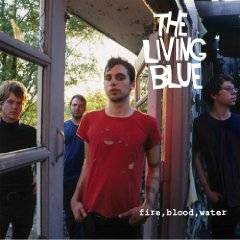 When The Blackouts changed their name to The Living Blue, most people in Champaign-Urbana decided to shrug their shoulders and keep right on sweatin’ it out with the band. This was their first and only album for Minty Fresh, who signed them in the hopes of jumping on board the “garage band” explosion of the early aughts. The songs here are sharp and willfully twisted, tightly produced and even faintly shiny. And while overall the record is a winner, it’s that glossy sheen in the production that kept it from ever taking the music to the heights that it leapt to from the band’s debut album, Everyday Is a Sunday Evening, to their followup, Living in Blue. –SETH FEIN
When The Blackouts changed their name to The Living Blue, most people in Champaign-Urbana decided to shrug their shoulders and keep right on sweatin’ it out with the band. This was their first and only album for Minty Fresh, who signed them in the hopes of jumping on board the “garage band” explosion of the early aughts. The songs here are sharp and willfully twisted, tightly produced and even faintly shiny. And while overall the record is a winner, it’s that glossy sheen in the production that kept it from ever taking the music to the heights that it leapt to from the band’s debut album, Everyday Is a Sunday Evening, to their followup, Living in Blue. –SETH FEIN
Rob McColley
Sings Insults to An Ex-Girlfriend and an Unrelated Song About Television, Because How Much Can You Really Say About One Not Very Complex, Dishonest Person
(Legal, 2004)
Listen to “#68” by Rob McColley
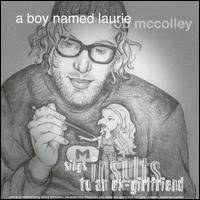 Perhaps the most maligned and rejected of all C-U singer-songwriters of the decade, Smile Politely columnist and 2009 Urbana mayoral candidate Rob McColley called two local labels (Parasol and then Hammerhead) home before being forced to go truly “indie” and start releasing albums under his own Legal Records. His 2004 album wasn’t just honest; it was direct and insulting — as the title suggests. Each of these tunes are masterfully produced and the story is a welcome one. Even though it can be painful to listen to (you’ll spend some time feeling bad for him, and some time feeling embarrassed for him), it’s worth every dirty moment. –SETH FEIN
Perhaps the most maligned and rejected of all C-U singer-songwriters of the decade, Smile Politely columnist and 2009 Urbana mayoral candidate Rob McColley called two local labels (Parasol and then Hammerhead) home before being forced to go truly “indie” and start releasing albums under his own Legal Records. His 2004 album wasn’t just honest; it was direct and insulting — as the title suggests. Each of these tunes are masterfully produced and the story is a welcome one. Even though it can be painful to listen to (you’ll spend some time feeling bad for him, and some time feeling embarrassed for him), it’s worth every dirty moment. –SETH FEIN
The Mezzanines
Underground Aces
(Mud, 2000)
Listen to “Creative Temperament” by The Mezzanines
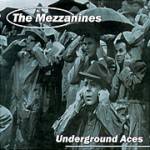 This Mezzanines released these 13 tracks of lo-fi power-pop in January of 2000, making Underground Aces the oldest release on our list. Together, vocalist/guitarist/songwriter Mark Baldwin (Love Cup), bassist Matt Fillipo (Tractor Kings), and drummer Colin Koteles (Menthol), do their best to impersonate the oddball classic rock aesthetic and lyrical bent of Guided By Voices and The Flaming Lips. The results are enjoyable, if less weird and charming than on their self-titled debut. –DOUG HOEPKER
This Mezzanines released these 13 tracks of lo-fi power-pop in January of 2000, making Underground Aces the oldest release on our list. Together, vocalist/guitarist/songwriter Mark Baldwin (Love Cup), bassist Matt Fillipo (Tractor Kings), and drummer Colin Koteles (Menthol), do their best to impersonate the oddball classic rock aesthetic and lyrical bent of Guided By Voices and The Flaming Lips. The results are enjoyable, if less weird and charming than on their self-titled debut. –DOUG HOEPKER
New Ruins
The Sound They Make
(Hidden Agenda, 2007)
Listen to “Ships” by New Ruins
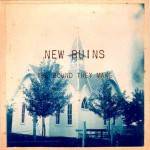 Illinoisan in every aspect, this lushly layered pop gem conceived by childhood friends Elzie Sexton and J. Caleb Means (and performed with veteran C-Uites Roy Ewing and Paul Chastain) is full of light and dark alike — rich in aural texture and literate in content. Think Silver Jews with a more poppy flair and you’re close; a listen will get you even closer. –ZACK ADCOCK
Illinoisan in every aspect, this lushly layered pop gem conceived by childhood friends Elzie Sexton and J. Caleb Means (and performed with veteran C-Uites Roy Ewing and Paul Chastain) is full of light and dark alike — rich in aural texture and literate in content. Think Silver Jews with a more poppy flair and you’re close; a listen will get you even closer. –ZACK ADCOCK
Rectangle
Uno Nunca Sabe
(Stereoriffic, 2003)
Listen to “Hit My Heart Wrong” by Rectangle
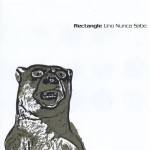 After eons of dealing in obtuse word salad and Polvo-esque, detuned jigsaw puzzles, Rectangle doused their heckler spray with doo-wop vocals and brought on the major leagues with 2003’s Uno Nunca Sabe. Six years later, it reads like their masterpiece, a truly adventurous concept record about the shakiness of indie rock’s DIY stance in the face of homeowners who “wouldn’t understand” and café careerists who “satisfy demands”; taken in context, however, it was simply an out-of-style outlier, the best album C-U forgot to hear that year. –JOSEPH MARTIN
After eons of dealing in obtuse word salad and Polvo-esque, detuned jigsaw puzzles, Rectangle doused their heckler spray with doo-wop vocals and brought on the major leagues with 2003’s Uno Nunca Sabe. Six years later, it reads like their masterpiece, a truly adventurous concept record about the shakiness of indie rock’s DIY stance in the face of homeowners who “wouldn’t understand” and café careerists who “satisfy demands”; taken in context, however, it was simply an out-of-style outlier, the best album C-U forgot to hear that year. –JOSEPH MARTIN
The Red Hot Valentines
Summer Fling
(Polyvinyl, 2003)
Listen to “All You Get” by The Red Hot Valentines
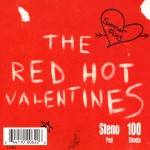 Songwriters Toby Kirk and Jeff Johnson met at Lincoln Christian College before moving to Champaign to explore a larger college market. The time was right for the Valentines to capitalize on their hook-filled, moog-flavored pop-punk. The high school and college kids — and their radio station, WPGU — reciprocated the interest and helped the band land a deal with Polyvinyl and become part of the national emo rock scene. It’s safe to say the Valentines never fit in with the greater indie rock scene in C-U, but then again that was never the point. In the end they made it far bigger than most of their detractors. –DOUG HOEPKER
Songwriters Toby Kirk and Jeff Johnson met at Lincoln Christian College before moving to Champaign to explore a larger college market. The time was right for the Valentines to capitalize on their hook-filled, moog-flavored pop-punk. The high school and college kids — and their radio station, WPGU — reciprocated the interest and helped the band land a deal with Polyvinyl and become part of the national emo rock scene. It’s safe to say the Valentines never fit in with the greater indie rock scene in C-U, but then again that was never the point. In the end they made it far bigger than most of their detractors. –DOUG HOEPKER
Adam Schmitt
Demolition
(Parasol, 2001)
Listen to “Looking for Fate” by Adam Schmitt
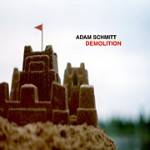 No one in C-U can craft a pop hook as well as Schmitt, and it’s telling that his sonic fingerprint as producer is on many of this decade’s best local recordings. It’s no disservice to Schmitt if I tell you to seek out his two early ’90s albums on Reprise — World So Bright and Illiterature — before you pick up Demolition, which, as the title suggests, is to the songwriter a rougher collection that lacks the polish of his power-pop masterpieces. Still, Demolition features some real gems in “See Me Fall,” “Brilliance in Failure,” the eerily timed “Alone on a Crashing Plane” (the record was released on Tuesday, Sept. 11, 2001), and “Looking for Fate” that illustrate why his back catalog should have found more than critical success. –DOUG HOEPKER
No one in C-U can craft a pop hook as well as Schmitt, and it’s telling that his sonic fingerprint as producer is on many of this decade’s best local recordings. It’s no disservice to Schmitt if I tell you to seek out his two early ’90s albums on Reprise — World So Bright and Illiterature — before you pick up Demolition, which, as the title suggests, is to the songwriter a rougher collection that lacks the polish of his power-pop masterpieces. Still, Demolition features some real gems in “See Me Fall,” “Brilliance in Failure,” the eerily timed “Alone on a Crashing Plane” (the record was released on Tuesday, Sept. 11, 2001), and “Looking for Fate” that illustrate why his back catalog should have found more than critical success. –DOUG HOEPKER
Shipwreck
Origin
(Self-Released, 2005)
Listen to “Telegram” by Shipwreck
 On Origin, Shipwreck solidified from the intriguing but shaky ground of its inception to build a set of songs that befit its members’ eclectic musical tastes (Radiohead, Skip Spence, Will Oldham, Pabst Blue Ribbon, etc.) and capitalize on the loose, sometimes psychedelic ends apparent on the band’s debut E.P., Six Buttery Mega-hits. As a result, Origin is tight, desperate, and just off-center enough to be intriguing and raise questions, while still remaining deliberate and solid. –ZACK ADCOCK
On Origin, Shipwreck solidified from the intriguing but shaky ground of its inception to build a set of songs that befit its members’ eclectic musical tastes (Radiohead, Skip Spence, Will Oldham, Pabst Blue Ribbon, etc.) and capitalize on the loose, sometimes psychedelic ends apparent on the band’s debut E.P., Six Buttery Mega-hits. As a result, Origin is tight, desperate, and just off-center enough to be intriguing and raise questions, while still remaining deliberate and solid. –ZACK ADCOCK
Smile Politely’s Top 20 C-U Albums of the Decade
20. Wolfie
Tall Dark Hill
(March Records, 2001)
Listen to “Everybody Knows How to Cry” by Wolfie
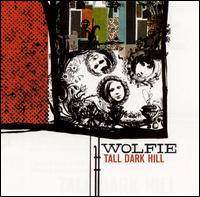 Wolfie was a spry, stripped-down twee-pop band when they debuted in 1997 with a single on Grand Theft Autumn. Heavy on elementary synth melodies, jangly guitar, boy-girl harmonies, and Joe Ziemba’s affected, nasally vocals, the group’s debut full length for Mud sounded like The Rentals high-fiving Bunnygrunt. They were the band that Pitchfork loved to hate. But in just four short years, Ziemba, Amanda Lyons, and Mike Downey had grown up considerably, fully realizing their inner Kinkdom while adding both musculature and texture to their youthful, bare-bones sound. The songs on Tall Dark Hill are simply more substantial and interesting, relying on something greater than raw energy to carry their weight. Lyons became more than just a backup singer, taking the lead on a few tracks while providing sugar to Ziemba’s spice. Tall Dark Hill is an addicting slice of playful power pop released on what was one of the nation’s foremost labels for such fare, Skippy McFadden’s March Records. But Wolfie had stretched the formula about as far as it could go, and soon after this record’s release the band split up, with Ziemba and Lyons (who had already partnered together musically as Busytoby) moving to Chicago and forming The Like Young, and Downey forging ahead with The New Constitution and The National Splits. –DOUG HOEPKER
Wolfie was a spry, stripped-down twee-pop band when they debuted in 1997 with a single on Grand Theft Autumn. Heavy on elementary synth melodies, jangly guitar, boy-girl harmonies, and Joe Ziemba’s affected, nasally vocals, the group’s debut full length for Mud sounded like The Rentals high-fiving Bunnygrunt. They were the band that Pitchfork loved to hate. But in just four short years, Ziemba, Amanda Lyons, and Mike Downey had grown up considerably, fully realizing their inner Kinkdom while adding both musculature and texture to their youthful, bare-bones sound. The songs on Tall Dark Hill are simply more substantial and interesting, relying on something greater than raw energy to carry their weight. Lyons became more than just a backup singer, taking the lead on a few tracks while providing sugar to Ziemba’s spice. Tall Dark Hill is an addicting slice of playful power pop released on what was one of the nation’s foremost labels for such fare, Skippy McFadden’s March Records. But Wolfie had stretched the formula about as far as it could go, and soon after this record’s release the band split up, with Ziemba and Lyons (who had already partnered together musically as Busytoby) moving to Chicago and forming The Like Young, and Downey forging ahead with The New Constitution and The National Splits. –DOUG HOEPKER
19. The Viper and His Famous Orchestra
Everything for Everyone
(Big Mono/Undertow, 2002)
Listen to “Randolph St.” by The Viper
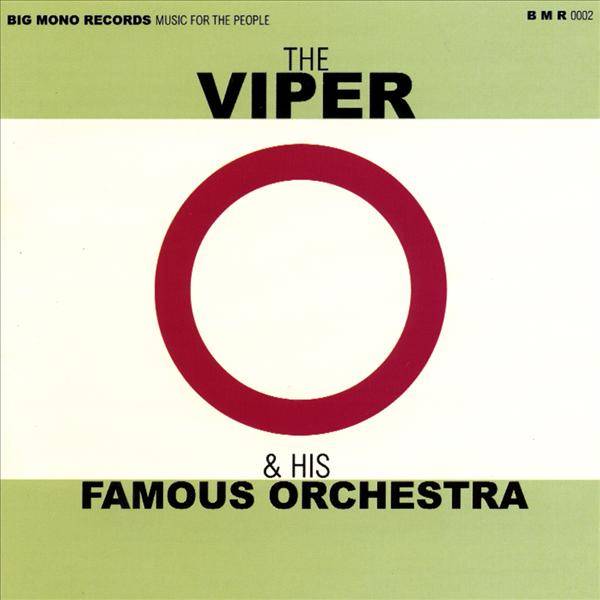 As with any pop comedown, the emo hangover of the early aughts found Champaign’s melodic class lost in the hinterlands. Bands were still around, sure, but most of the town’s brand names had decamped for Chicago and graduate studies, leaving the scene scrawny and scattered. Happily, it was a perfect context for Sheboygan (Wisc.) native and ardent GEO man Ryan Jerving (a.k.a. the Viper) to set His Famous Orchestra’s Broadway-gazing throwback shuffle to tape, a task he took on with gusto on 2002’s Everything for Everybody. Coming on like a chipper Cultural Studies salon, Everybody takes a certain giddy pleasure in Champaign’s musical diaspora, pitting ukelele-lead Liz Phair covers (“Dance of the Seven Veils”) against sundry Midwestern drinking chants, morphing The Music Man’s “Trouble” into Marxist skiffle (“Das Kapital”), and rearranging George Gershwin’s “Rhapsody in Blue” for beaten suitcase, uke, and Tin Pan Alley horn section. Seven years later, it still stands tall in C-U’s annals as a marvel of genre-melting collage, but what makes Everybody a keeper is the way Jay Bennett’s production serves up the Orchestra’s clatter: however novel the Viper’s ideas, the late engineer’s scruffy clarity always leaves sarcasm and cheese at the door, letting the band’s swinging anachronisms (and banter) mete out the record’s time. –JOSEPH MARTIN
As with any pop comedown, the emo hangover of the early aughts found Champaign’s melodic class lost in the hinterlands. Bands were still around, sure, but most of the town’s brand names had decamped for Chicago and graduate studies, leaving the scene scrawny and scattered. Happily, it was a perfect context for Sheboygan (Wisc.) native and ardent GEO man Ryan Jerving (a.k.a. the Viper) to set His Famous Orchestra’s Broadway-gazing throwback shuffle to tape, a task he took on with gusto on 2002’s Everything for Everybody. Coming on like a chipper Cultural Studies salon, Everybody takes a certain giddy pleasure in Champaign’s musical diaspora, pitting ukelele-lead Liz Phair covers (“Dance of the Seven Veils”) against sundry Midwestern drinking chants, morphing The Music Man’s “Trouble” into Marxist skiffle (“Das Kapital”), and rearranging George Gershwin’s “Rhapsody in Blue” for beaten suitcase, uke, and Tin Pan Alley horn section. Seven years later, it still stands tall in C-U’s annals as a marvel of genre-melting collage, but what makes Everybody a keeper is the way Jay Bennett’s production serves up the Orchestra’s clatter: however novel the Viper’s ideas, the late engineer’s scruffy clarity always leaves sarcasm and cheese at the door, letting the band’s swinging anachronisms (and banter) mete out the record’s time. –JOSEPH MARTIN
18. The Elanors
A Year to Demonstrate
(Isidore, 2005)
Listen to “Roads to Freedom” by The Elanors
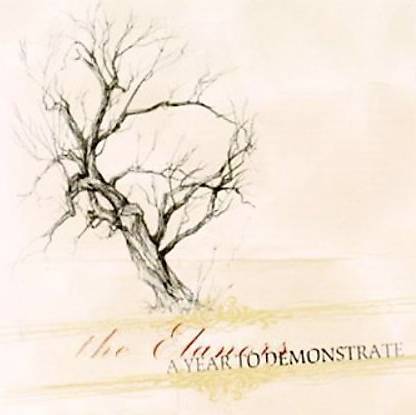 Perhaps it’s fitting that the first song on the first Elanors record, A Year to Demonstrate, began with the sound of a typewriter clicking away in a rhythmic pattern. Theirs is a story that is still being told. While the band dissolved officially somewhere between 2006 and 2007, the relationship that gave birth to the project is stronger than ever. Noah and Adriel Harris, husband and wife, are anything but finished telling their story as musicians. Now members of Cory Chisel and The Wandering Sons, the two find themselves globetrotting most of the year in support of their major label debut on the RCA subsidiary Black Seal. So while The Elanors may no longer be playing shows and writing albums, the band’s spirit very much lives on.
Perhaps it’s fitting that the first song on the first Elanors record, A Year to Demonstrate, began with the sound of a typewriter clicking away in a rhythmic pattern. Theirs is a story that is still being told. While the band dissolved officially somewhere between 2006 and 2007, the relationship that gave birth to the project is stronger than ever. Noah and Adriel Harris, husband and wife, are anything but finished telling their story as musicians. Now members of Cory Chisel and The Wandering Sons, the two find themselves globetrotting most of the year in support of their major label debut on the RCA subsidiary Black Seal. So while The Elanors may no longer be playing shows and writing albums, the band’s spirit very much lives on.
While in C-U, The Elanors struggled to find hushed spaces to perform that could capture the group’s gentle quietude and somber melancholic position. Though he mainly played guitar on A Year to Demonstrate, Noah quickly adapted his live set with the help of Adriel; he played piano, she took over on baritone guitar. Each song on the album is deftly executed with the type of honesty that only self-production and inexperience can deliver. The structures are simple; the listener is never confused by a transition or an additional instrument being tossed into the mix. And that is a good thing for a band like this. After all, Noah and Adriel, by any standards, are some of the most lovely people you may ever meet. It is only fitting that their songs followed suit. –SETH FEIN
17. Terminus Victor
Under Surveillance
(Innocent Words, 2005)
Listen to “Your Nemesis” by Terminus Victor
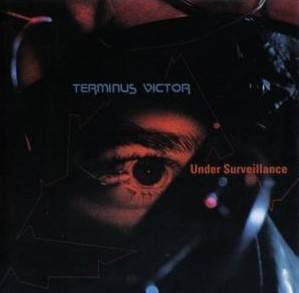 Scott Kimble and Don King are C-U’s odd couple: Don, clean-shaven and well kempt in a suit and tie; Scott, in grungy black, a wool hat pulled low over his brow, his face scruffy. Visually, the pair embrace the Cheap Trick dichotomy; musically, however, they favor another northern Illinois institution, Big Black. In 2005, the guitar-bass duo was backed by a hostile drum machine (simply named “She”), which added the fitting touch for a band playing industrial rock at a deafening level. Terminus Victor’s live show at this time was so intense — loud, bright, heavy on the senses — that it often scared away a good portion of the crowd, many of whom opted for slightly quieter, distant corners of the venue. For those who stuck around for the show, a point was driven home: Terminus Victor did its own thing, bystanders be damned. And by the time Under Surveillance, the band’s second record for Innocent Words, came out, they were balancing the propulsive low-end of their music with more melodic leads on guitar and vocals. The record reveals a texture and tunefulness that may have been overshadowed live by the sheer volume of their sets. The Touch and Go influence still hangs heavy on Under Surveillance, but on “A Scream in the Park” Kimble’s voice cuts through the mix during the verse to reveal an approachable melody, and King’s guitar is more atmospheric than abrasive. “Your Nemesis” is ready for radio airplay (it did get some spins locally) and highlights the duo’s capability of penning a memorable chorus. They eventually kicked “She” to the curb and added a human on drums, but for six years Terminus Victor toiled in the trenches as a two-man, one-machine wrecking crew and one of C-U’s heaviest bands. –DOUG HOEPKER
Scott Kimble and Don King are C-U’s odd couple: Don, clean-shaven and well kempt in a suit and tie; Scott, in grungy black, a wool hat pulled low over his brow, his face scruffy. Visually, the pair embrace the Cheap Trick dichotomy; musically, however, they favor another northern Illinois institution, Big Black. In 2005, the guitar-bass duo was backed by a hostile drum machine (simply named “She”), which added the fitting touch for a band playing industrial rock at a deafening level. Terminus Victor’s live show at this time was so intense — loud, bright, heavy on the senses — that it often scared away a good portion of the crowd, many of whom opted for slightly quieter, distant corners of the venue. For those who stuck around for the show, a point was driven home: Terminus Victor did its own thing, bystanders be damned. And by the time Under Surveillance, the band’s second record for Innocent Words, came out, they were balancing the propulsive low-end of their music with more melodic leads on guitar and vocals. The record reveals a texture and tunefulness that may have been overshadowed live by the sheer volume of their sets. The Touch and Go influence still hangs heavy on Under Surveillance, but on “A Scream in the Park” Kimble’s voice cuts through the mix during the verse to reveal an approachable melody, and King’s guitar is more atmospheric than abrasive. “Your Nemesis” is ready for radio airplay (it did get some spins locally) and highlights the duo’s capability of penning a memorable chorus. They eventually kicked “She” to the curb and added a human on drums, but for six years Terminus Victor toiled in the trenches as a two-man, one-machine wrecking crew and one of C-U’s heaviest bands. –DOUG HOEPKER
16. Ryan Groff
People in the Midwest
(Parasol, 2007)
Listen to “Landlocked” by Ryan Groff
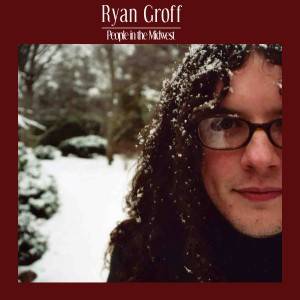 Groff’s People in the Midwest sets out to do exactly what it wants. Each delicately arranged track creates the feeling of lying in the snow, dead grass poking through the white — as Groff puts it, “landlocked by cash crops.” As we all know, there’s something beautiful and miserable about the infinite flatness of Central Illinois, the giant sky, the soft shoulders and hard winters. Groff explores that Midwest-feeling with thoughtfulness, complexity, and even humor as he prophesizes on a pre-Elsinore version of “Landlocked”: “We’ll all be wearing umbrella hats in twenty years or so.” I can’t say I haven’t thought about taking the leap, myself.
Groff’s People in the Midwest sets out to do exactly what it wants. Each delicately arranged track creates the feeling of lying in the snow, dead grass poking through the white — as Groff puts it, “landlocked by cash crops.” As we all know, there’s something beautiful and miserable about the infinite flatness of Central Illinois, the giant sky, the soft shoulders and hard winters. Groff explores that Midwest-feeling with thoughtfulness, complexity, and even humor as he prophesizes on a pre-Elsinore version of “Landlocked”: “We’ll all be wearing umbrella hats in twenty years or so.” I can’t say I haven’t thought about taking the leap, myself.
On standout “Haiti,” Groff attacks the electric guitar like Britt Daniel while reaching Thom Yorke levels on the falsetto scale. At the end of the track, he’s even breaking out some pre-Bon Iver chamber harmonies. These comparisons don’t come up because Groff is retreading familiar territory, but because they serve as appropriate benchmarks to show his level of talent as a songwriter and musician. If you see Groff perform live, with Elsinore or solo, you can look around and literally watch the jaws drop. This album is a perfect and beautiful example of why. –BRIAN McGOVERN
15. Jay Bennett & Edward Burch
The Palace at 4 a.m. (Part 1)
(Undertow, 2002)
Listen to “Talk to Me” by Jay Bennett & Edward Burch
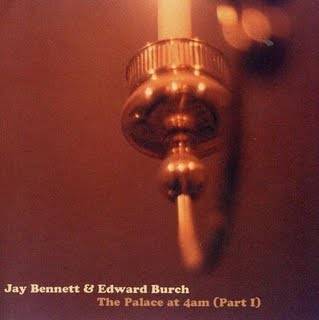 When not on tour or in the studio with Wilco, Jay Bennett resided in a downtown Champaign loft space, where he began, in 1995, writing and tracking the songs that would eventually end up on Palace. Edward Burch, his good friend, roomy, and a likeminded local musician (The Kennett Brothers, The Viper), contributed to the songwriting and recording process. After Bennett and Wilco parted ways in 2001 following the release of Yankee Hotel Foxtrot, Bennett and Burch focused their energies on completing Palace, which came out the following year. Bennett was living in Chicago by this time, but Burch was still living in town (Bennett wouldn’t move back to town until around 2005) and some of the songs were mixed and mastered by Jonathan Pines at his Urbana studio. So, we certainly count this record as one with deep C-U roots.
When not on tour or in the studio with Wilco, Jay Bennett resided in a downtown Champaign loft space, where he began, in 1995, writing and tracking the songs that would eventually end up on Palace. Edward Burch, his good friend, roomy, and a likeminded local musician (The Kennett Brothers, The Viper), contributed to the songwriting and recording process. After Bennett and Wilco parted ways in 2001 following the release of Yankee Hotel Foxtrot, Bennett and Burch focused their energies on completing Palace, which came out the following year. Bennett was living in Chicago by this time, but Burch was still living in town (Bennett wouldn’t move back to town until around 2005) and some of the songs were mixed and mastered by Jonathan Pines at his Urbana studio. So, we certainly count this record as one with deep C-U roots.
Palace was met with critical ambivalence (while David Fricke liked it, Pitchfork offered a snarky, mediocre review), which is puzzling because the songwriting is at times exceptional and the arrangements often top notch. So much was made in the press of Bennett’s infighting with Jeff Tweedy and YHF producer Jim O’Rourke that Bennett’s departure from the band had been built up to a mythical level of martyrdom by some. “He made YHF what it was,” they exclaimed. Those folks expected Palace to be a stunning album, and it is simply not that good. Likewise, too many critics projected Palace to be like a YHF b-sides collection, which it most certainly is not. Part of the reason Bennett’s tenure in Wilco ended so abruptly during the group’s songwriting apex was that he had his own unique ideas and was a more than capable songwriter in his own right. Anyone who had heard Titanic Love Affair already knew that.
Burch says that Bennett saw Palace as an opportunity to prove his worth as a songwriter and producer, to showcase his own vision, and to my ears he did just that. Palace delivers a synthesis of Bennett and Burch’s influences: the Elvis Costello-esque “Whispers or Screams”; the twangy pop of “Puzzle Heart” and “Talk to Me”; the grandiose, ’70s singer-songwriter flair of “Drinking on Your Dime”; a number of melancholic, melodic tunes; and, yes, a pair of songs co-written with Tweedy and a pair of Woody Guthrie-penned Mermaid Avenue outtakes. This was no YHF, pt. 2; it was the Palace at 4 a.m. (Part 1). That fact may have given some fans pause, but screw ’em: this is a record that is long overdue for some love, locally and beyond. –DOUG HOEPKER
14. Krukid
African
(Rawkus, 2007)
Listen to “K-R-U” by Krukid
 In a time when hip-hop has a lot of artists running in place (thank Text for that one), Krukid’s African breaks the treadmill cycle in cadences and colors that the artist had only begun to explore on his first release, Raisin in the Sun. A 13-track romp ranging from party bangers (“K-R-U”) to the politically touching (“Invisible”), Krukid seems to be trying to send a song out to any and everyone that he can reach. He even goes so far as to offer a sense of courtesy as part of the hard work he has accomplished (“Thank You”), as well as what Champaign’s hip-hop scene did for him. With material like this, it’s no wonder there is significant buzz building behind the Ugandan-born MC, who always seems to have a million projects lining his plate. He’s a true shining gem of not only Champaign, but Midwest hip-hop as a whole. –EDWARD MOSES
In a time when hip-hop has a lot of artists running in place (thank Text for that one), Krukid’s African breaks the treadmill cycle in cadences and colors that the artist had only begun to explore on his first release, Raisin in the Sun. A 13-track romp ranging from party bangers (“K-R-U”) to the politically touching (“Invisible”), Krukid seems to be trying to send a song out to any and everyone that he can reach. He even goes so far as to offer a sense of courtesy as part of the hard work he has accomplished (“Thank You”), as well as what Champaign’s hip-hop scene did for him. With material like this, it’s no wonder there is significant buzz building behind the Ugandan-born MC, who always seems to have a million projects lining his plate. He’s a true shining gem of not only Champaign, but Midwest hip-hop as a whole. –EDWARD MOSES
13. Unbunny
Snow Tires
(Hidden Agenda, 2004)
Listen to “Casserole” by Unbunny
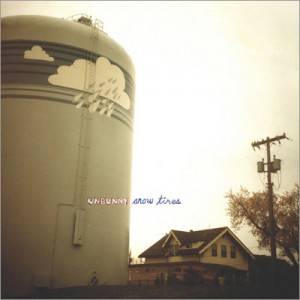 “In a Way,” the lead song from Unbunny’s 2002 album Black Strawberries, served as my introduction to Jarid del Deo, who moved to town that year from Seattle with his girlfriend. Musically, “In a Way” explored the largely acoustic-guitar-based Neutral Milk Hotel-cum-Neil Young aesthetic that defined Unbunny. But it was a lyric in the song that perfectly encapsulated del Deo’s musical message and began my love affair with Unbunny: “everybody wins is just a saying to keep the losers feeling lucky.” He had me hooked, and on Snow Tires, an austere album largely about the dissolution of the relationship that brought him to C-U, del Deo delivered his masterpiece: a mid-tempo collection of affecting pop songs. His sound growing to incorporate more electric guitar, piano, and subtle flourishes of noise, Unbunny nailed it. Parts of the record were mastered by Adam Schmitt and recorded in town with Roy Ewing and Paul Chastain backing del Deo. Yet too few ever heard Unbunny’s dulcet melodies, because del Deo rarely played out and mostly kept to himself. By the time Snow Tires saw its release on Hidden Agenda, the songwriter was en route back to the Pacific Northwest. Upon hearing lines like this, from “I Knock Things I Haven’t Tried,” you begin to understand the sort of sorrow that forced him to flee the biting Midwestern winters and return to familiar faces: “You could say, you would say, I’m like all these decomposing leaves — dark and heavy.” Even sadder than that lyric: you probably don’t have enough Unbunny in your life. –DOUG HOEPKER
“In a Way,” the lead song from Unbunny’s 2002 album Black Strawberries, served as my introduction to Jarid del Deo, who moved to town that year from Seattle with his girlfriend. Musically, “In a Way” explored the largely acoustic-guitar-based Neutral Milk Hotel-cum-Neil Young aesthetic that defined Unbunny. But it was a lyric in the song that perfectly encapsulated del Deo’s musical message and began my love affair with Unbunny: “everybody wins is just a saying to keep the losers feeling lucky.” He had me hooked, and on Snow Tires, an austere album largely about the dissolution of the relationship that brought him to C-U, del Deo delivered his masterpiece: a mid-tempo collection of affecting pop songs. His sound growing to incorporate more electric guitar, piano, and subtle flourishes of noise, Unbunny nailed it. Parts of the record were mastered by Adam Schmitt and recorded in town with Roy Ewing and Paul Chastain backing del Deo. Yet too few ever heard Unbunny’s dulcet melodies, because del Deo rarely played out and mostly kept to himself. By the time Snow Tires saw its release on Hidden Agenda, the songwriter was en route back to the Pacific Northwest. Upon hearing lines like this, from “I Knock Things I Haven’t Tried,” you begin to understand the sort of sorrow that forced him to flee the biting Midwestern winters and return to familiar faces: “You could say, you would say, I’m like all these decomposing leaves — dark and heavy.” Even sadder than that lyric: you probably don’t have enough Unbunny in your life. –DOUG HOEPKER
12. Tractor Kings
Gone to Heaven
(Mud, 2003)
Listen to “Gone to Heaven” by Tractor Kings
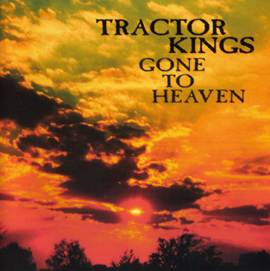 If Jacob Fleischli had never written another song other than the title cut to his second album, Gone to Heaven, the Tractor Kings would still hold a special place in my twangy heart. “Gone to Heaven,” the song, details a romantic quandary through the eyes of a feeble man. The second verse is possibly the most memorable one penned this decade by a native of our twin towns: “All this drinkin’, and being on drugs / I’d like to say I’ve had enough / But I’ll have some more, if you walk in the door / I think tonight I’m gonna score.” Live, Fleischli would often sneer while singing the line about having had enough, so when listening to the lyric now I imagine him in my head, Cardinals ball cap pulled tight over his head, face tilted and twisted, left hand strangling the neck of his acoustic 12-string guitar. This reverb-drenched, pedal steel-speckled, mid-tempo country & western ballad sounds absolutely angelic on the hi-fi. Matt Talbott did a fantastic job producing the entire LP, but on this particular song he succinctly compresses the whole as it outshines the mighty parts Fleischli organized for the recording: Matt Filippo on bass, Angie Heaton on drums, Steve Ucherek on electric guitar, and R.M. Racky on steel guitar. As for the rest of the record, it’s a definite keeper, too. –DOUG HOEPKER
If Jacob Fleischli had never written another song other than the title cut to his second album, Gone to Heaven, the Tractor Kings would still hold a special place in my twangy heart. “Gone to Heaven,” the song, details a romantic quandary through the eyes of a feeble man. The second verse is possibly the most memorable one penned this decade by a native of our twin towns: “All this drinkin’, and being on drugs / I’d like to say I’ve had enough / But I’ll have some more, if you walk in the door / I think tonight I’m gonna score.” Live, Fleischli would often sneer while singing the line about having had enough, so when listening to the lyric now I imagine him in my head, Cardinals ball cap pulled tight over his head, face tilted and twisted, left hand strangling the neck of his acoustic 12-string guitar. This reverb-drenched, pedal steel-speckled, mid-tempo country & western ballad sounds absolutely angelic on the hi-fi. Matt Talbott did a fantastic job producing the entire LP, but on this particular song he succinctly compresses the whole as it outshines the mighty parts Fleischli organized for the recording: Matt Filippo on bass, Angie Heaton on drums, Steve Ucherek on electric guitar, and R.M. Racky on steel guitar. As for the rest of the record, it’s a definite keeper, too. –DOUG HOEPKER
11. Centaur
In Streams
(Martians Go Home/Parasol, 2002)
Listen to “Wait for the Sun” by Centaur
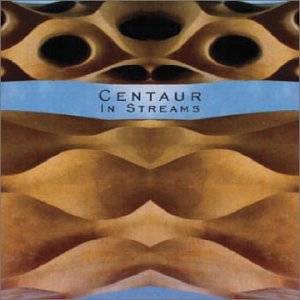 Centaur receives most of its publicity for being Matt Talbott’s post-Hum project, formed shortly after Hum finished out the last run of shows in its (from the outside, at least) fairytale career. But Centaur is more of a group of domestic celebrity, one whose collective creative strengths are unwavering. In Streams is far more than the logical progression from Hum — a comparison that, in itself, is not completely fair. For practical purposes, though, Talbott’s vocals are at the center of Centaur’s sound, whereas in Hum his vocals were buried in a barrage of disarming noise, and on In Streams the band (comprised of Talbott and fellow C-U veterans Derek Niedringhaus on bass and Jim Kelly on drums) flawlessly shifts from deliberate and pensive structures to more familiar raucous ground — as heard on the schizophrenic outro to “Stranger on 5” as well as the epic title track. In Streams is psychedelic and rich, and Centaur has so far proven to be the most personal of all of Talbott’s projects. Playing on the themes of tragedy in both life and death, In Streams is stunning, filled with songs that are at once hopeful and helpless, cryptic and intensely personal. –ZACK ADCOCK
Centaur receives most of its publicity for being Matt Talbott’s post-Hum project, formed shortly after Hum finished out the last run of shows in its (from the outside, at least) fairytale career. But Centaur is more of a group of domestic celebrity, one whose collective creative strengths are unwavering. In Streams is far more than the logical progression from Hum — a comparison that, in itself, is not completely fair. For practical purposes, though, Talbott’s vocals are at the center of Centaur’s sound, whereas in Hum his vocals were buried in a barrage of disarming noise, and on In Streams the band (comprised of Talbott and fellow C-U veterans Derek Niedringhaus on bass and Jim Kelly on drums) flawlessly shifts from deliberate and pensive structures to more familiar raucous ground — as heard on the schizophrenic outro to “Stranger on 5” as well as the epic title track. In Streams is psychedelic and rich, and Centaur has so far proven to be the most personal of all of Talbott’s projects. Playing on the themes of tragedy in both life and death, In Streams is stunning, filled with songs that are at once hopeful and helpless, cryptic and intensely personal. –ZACK ADCOCK
10. Poster Children
No More Songs About Sleep and Fire
(Hidden Agenda, 2004)
Listen to “Western Springs” by Poster Children
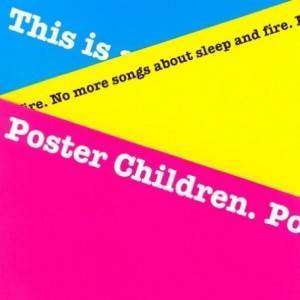 That 2004’s No More Songs About Sleep and Fire was the Poster Children’s apparent parting shot seems totally absurd; even a meth-addled teen in a Black Flag tee would have a rough time keeping up with the vitriolic jitters the Kids serve up here. But, to be fair, Fire was a product of the oft-combustible Bush years, meaning this model of the P Kids’ smoked (helped along by kinetic new skinsman Matt Friscia) with the inherited outrage of a thousand Reagan-era punkers. Fire dumped sixteen years of sleep and/or fire in lieu of Give ’em Enough Rope-style agitprop. The band didn’t entirely lose its taste for less divisive noise: wedged within the record’s post-9/11 recons (“Now It’s Gone”), abstracted polemics (“Flag,” “The Leader”), and temperance anthems (“The Bottle”) were winning post-punk nods to dead-eyed domesticity (“Western Springs”) and black-belted teen buddies (“Jane”) that deftly evaded both irony and schmaltz. Taken en bloc, though, Fire played like a political rebirth, a torch relay from the P Kids’ pissed off forebears — a set drenched in old-school righteous furor, but still honeyed enough to produce the familiar buzz of our favorite band of ADHD popsters sweating out its collective sugar high. –JOSEPH MARTIN
That 2004’s No More Songs About Sleep and Fire was the Poster Children’s apparent parting shot seems totally absurd; even a meth-addled teen in a Black Flag tee would have a rough time keeping up with the vitriolic jitters the Kids serve up here. But, to be fair, Fire was a product of the oft-combustible Bush years, meaning this model of the P Kids’ smoked (helped along by kinetic new skinsman Matt Friscia) with the inherited outrage of a thousand Reagan-era punkers. Fire dumped sixteen years of sleep and/or fire in lieu of Give ’em Enough Rope-style agitprop. The band didn’t entirely lose its taste for less divisive noise: wedged within the record’s post-9/11 recons (“Now It’s Gone”), abstracted polemics (“Flag,” “The Leader”), and temperance anthems (“The Bottle”) were winning post-punk nods to dead-eyed domesticity (“Western Springs”) and black-belted teen buddies (“Jane”) that deftly evaded both irony and schmaltz. Taken en bloc, though, Fire played like a political rebirth, a torch relay from the P Kids’ pissed off forebears — a set drenched in old-school righteous furor, but still honeyed enough to produce the familiar buzz of our favorite band of ADHD popsters sweating out its collective sugar high. –JOSEPH MARTIN
9. Menthol
Danger: Rock Science!
(Hidden Agenda, 2002)
Listen to “Danger: Rock Science!” by Menthol
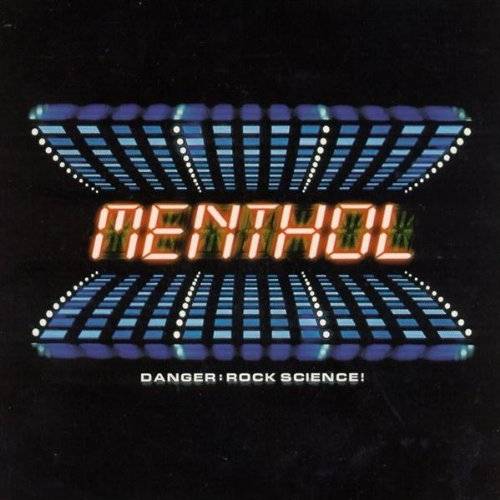 An odd, exuberant, and endlessly fun album, the sound of Danger: Rock Science! belies none of its knotty back-story. After recording their second album for Capitol records, Menthol discovered the label had decided the band’s homage to ’80s new wave was something of a commercial non-starter. After attempting to buy back the masters and arrange a (failed) co-release between Capitol and Hidden Agenda, the band went so far as to re-record the album, which was finally released in 2002. In the meantime, ’80s new wave had completely blown-up (oh the irony). Little of that debacle comes through on the album, though. The band dresses up its bent power-pop in spazzy new-wave clothes, marrying crunchy riffs to woozy, buzzy synth lines with a finesse and songwriting ability lost on many of their contemporaries. Odd flourishes thrown into familiar tropes abound, whether it’s the oddly-tuned riffage that punctuates the Cars-like “New Recruits” or Balthazar de Lay’s surreal, witty lyrics over the top of the Devo-style synth-pop of “Strange Living.” As the lead singer croons, “I could tell you ’bout the state I’m in / And you could be my Cocteau Twin,” every fan of eccentric pop should find it easy to forget all the drama surrounding the album’s release. –LOGAN MOORE
An odd, exuberant, and endlessly fun album, the sound of Danger: Rock Science! belies none of its knotty back-story. After recording their second album for Capitol records, Menthol discovered the label had decided the band’s homage to ’80s new wave was something of a commercial non-starter. After attempting to buy back the masters and arrange a (failed) co-release between Capitol and Hidden Agenda, the band went so far as to re-record the album, which was finally released in 2002. In the meantime, ’80s new wave had completely blown-up (oh the irony). Little of that debacle comes through on the album, though. The band dresses up its bent power-pop in spazzy new-wave clothes, marrying crunchy riffs to woozy, buzzy synth lines with a finesse and songwriting ability lost on many of their contemporaries. Odd flourishes thrown into familiar tropes abound, whether it’s the oddly-tuned riffage that punctuates the Cars-like “New Recruits” or Balthazar de Lay’s surreal, witty lyrics over the top of the Devo-style synth-pop of “Strange Living.” As the lead singer croons, “I could tell you ’bout the state I’m in / And you could be my Cocteau Twin,” every fan of eccentric pop should find it easy to forget all the drama surrounding the album’s release. –LOGAN MOORE
8. National Skyline
National Skyline
(Hidden Agenda, 2000)
Listen to “Metropolis” by National Skyline
 After the dissolution of Castor, one of the last bands from what is considered by some the musical heyday in C-U, Jeff Garber turned his attention toward redefining his work as a musician. He partnered with Jeff Dimpsey, a name familiar to those who know Hum like a best friend, to create one of the finest albums of C-U origin ever committed to tape. Recorded in the the lofts above Guidos on 2 E. Main St., this “mini-album” is perhaps one of the most relevant examples of how Radiohead’s Kid A captured the attention of an entire decade of musicians. After hearing the album, the duo scrapped a good portion of what was already on tape and began redesigning it. The result was nothing short of genius. The psychedelic effects used on the record almost perfectly supplement Garber’s hopeful vocals. The band’s simplistic approach to melody and rhythm is notable, but more than anything it is Dimpsey’s bass lines that carry the album. It could be argued that there has never been a local album so well constructed around a bass guitar. If it wasn’t produced with that in mind, it certainly comes off as such. And that is a good thing: Dimpsey is arguably the most effective and under-rated player in Champaign-Urbana’s illustrious music history. –SETH FEIN
After the dissolution of Castor, one of the last bands from what is considered by some the musical heyday in C-U, Jeff Garber turned his attention toward redefining his work as a musician. He partnered with Jeff Dimpsey, a name familiar to those who know Hum like a best friend, to create one of the finest albums of C-U origin ever committed to tape. Recorded in the the lofts above Guidos on 2 E. Main St., this “mini-album” is perhaps one of the most relevant examples of how Radiohead’s Kid A captured the attention of an entire decade of musicians. After hearing the album, the duo scrapped a good portion of what was already on tape and began redesigning it. The result was nothing short of genius. The psychedelic effects used on the record almost perfectly supplement Garber’s hopeful vocals. The band’s simplistic approach to melody and rhythm is notable, but more than anything it is Dimpsey’s bass lines that carry the album. It could be argued that there has never been a local album so well constructed around a bass guitar. If it wasn’t produced with that in mind, it certainly comes off as such. And that is a good thing: Dimpsey is arguably the most effective and under-rated player in Champaign-Urbana’s illustrious music history. –SETH FEIN
7. Shipwreck
Rabbit in the Kitchen With a New Dress On
(None, 2007)
Listen to “Rabbit in the Kitchen” by Shipwreck
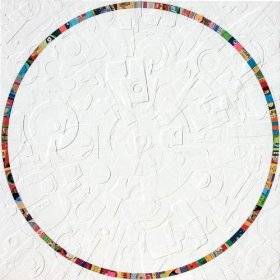 Shipwreck frontmen John Owen and Harman Jordan wrote distinctly different tunes: Owen favored accessible power-pop anthems (“Hi-Fi,” “House of Cards,” “Backbone”), whereas Jordan preferred darker, psychedelic parables drenched in reverb (“Black Moon,” “Melusine,” “Walk in the Woods”). Jordan spun curious yarns; Owen brought the fist-pumping good times. These opposites definitely attracted me, and many others, to Shipwreck’s sound. Another benefit of dueling singers was paramount to the band’s success: it provided the group with dueling lead guitarists. When one was singing lead, the other was playing lead guitar. And both Owen and Jordan are talented guitarists, capable of layering foreign sonic textures as easily as memorable hooks. As a songwriting tandem, they were tops. Sure, you could distill the band’s influences down to a handful of the most interesting ’80s bands: Echo & the Bunnymen or U2, for example. But once you move beyond some very general sonic similarities, Shipwreck doesn’t really sound like either of those bands. What Owen, Jordan, drummer Chris Waage, and bassist Vlad Brilliant manage to do on Rabbit is build a bridge from the past to the present with at-times dazzling impact. Of C-U’s indie rock bands of the latter half of this decade, they provided the most thrills for those seeking to exercise both sides of the brain. –DOUG HOEPKER
Shipwreck frontmen John Owen and Harman Jordan wrote distinctly different tunes: Owen favored accessible power-pop anthems (“Hi-Fi,” “House of Cards,” “Backbone”), whereas Jordan preferred darker, psychedelic parables drenched in reverb (“Black Moon,” “Melusine,” “Walk in the Woods”). Jordan spun curious yarns; Owen brought the fist-pumping good times. These opposites definitely attracted me, and many others, to Shipwreck’s sound. Another benefit of dueling singers was paramount to the band’s success: it provided the group with dueling lead guitarists. When one was singing lead, the other was playing lead guitar. And both Owen and Jordan are talented guitarists, capable of layering foreign sonic textures as easily as memorable hooks. As a songwriting tandem, they were tops. Sure, you could distill the band’s influences down to a handful of the most interesting ’80s bands: Echo & the Bunnymen or U2, for example. But once you move beyond some very general sonic similarities, Shipwreck doesn’t really sound like either of those bands. What Owen, Jordan, drummer Chris Waage, and bassist Vlad Brilliant manage to do on Rabbit is build a bridge from the past to the present with at-times dazzling impact. Of C-U’s indie rock bands of the latter half of this decade, they provided the most thrills for those seeking to exercise both sides of the brain. –DOUG HOEPKER
6. New Ruins
We Make Our Own Bad Luck
(Hidden Agenda, 2009)
Listen to “Lake” by New Ruins
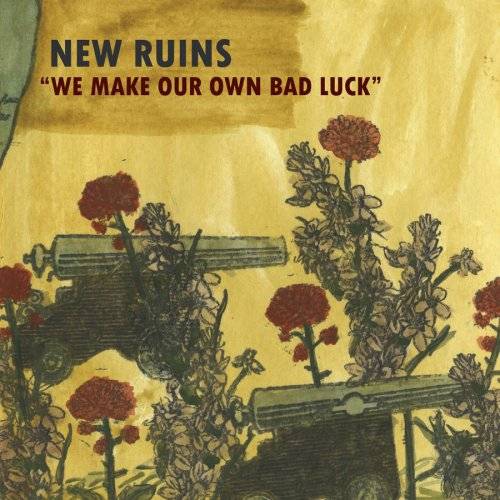 On We Make Our Own Bad Luck, New Ruins managed the tricky balancing act of solidifying into a bona fide band while maintaining the ghostly haziness that defined their previous efforts. Elzie Sexton and Caleb Means continued to reinterpret the gnarled roots of American vernacular music, making for an unorthodox but thoroughly Midwestern album, one where the sturdy foundations of soaring melodies and rootsy twang rub uncomfortably against electronic textures and other contemporary sounds. Far better than your average anachronistic “alt-country” album, We Make Our Own Bad Luck captures the loneliness of our current Midwestern landscape, cornfields abutting strip malls and the neon lights of a payday loan outfit buzzing in the shadow of a shuttered factory. The result is an album not easily categorized and all the more affecting for its ambiguity. –LOGAN MOORE
On We Make Our Own Bad Luck, New Ruins managed the tricky balancing act of solidifying into a bona fide band while maintaining the ghostly haziness that defined their previous efforts. Elzie Sexton and Caleb Means continued to reinterpret the gnarled roots of American vernacular music, making for an unorthodox but thoroughly Midwestern album, one where the sturdy foundations of soaring melodies and rootsy twang rub uncomfortably against electronic textures and other contemporary sounds. Far better than your average anachronistic “alt-country” album, We Make Our Own Bad Luck captures the loneliness of our current Midwestern landscape, cornfields abutting strip malls and the neon lights of a payday loan outfit buzzing in the shadow of a shuttered factory. The result is an album not easily categorized and all the more affecting for its ambiguity. –LOGAN MOORE
5. Headlights
Some Racing, Some Stopping
(Polyvinyl, 2008)
Listen to “Cherry Tulips” by Headlights
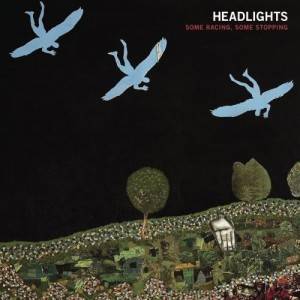 As has been pointed out, ad infinitum, lists are an arbitrary beast, as likely to offend or misrepresent, as they are to confirm or gratify. Who knows if Headlights’ Some Racing, Some Stopping really is the fifth best album to come out of C-U in the last decade? Rather than assign a number, we can discuss what aspects of this album outpaced all other contenders. Has any C-U band produced a more elegant earworm than “Cherry Tulips”? Or captured the ennui of small, Midwestern towns with more propulsive grace than “Market Girl”? Some Racing was a quantum leap forward from the band’s previous effort, 2007’s Kill Them With Kindness, inspired as much by place as emotion; by the farm house the album was recorded in and the lengthy, Illinois winters and oppressive summers the album seems to soundtrack. Practically an anachronism in this decade, Headlights crafted an album of beautiful pop music, moving in its simplicity and elegance, an act difficult to quantify. –LOGAN MOORE
As has been pointed out, ad infinitum, lists are an arbitrary beast, as likely to offend or misrepresent, as they are to confirm or gratify. Who knows if Headlights’ Some Racing, Some Stopping really is the fifth best album to come out of C-U in the last decade? Rather than assign a number, we can discuss what aspects of this album outpaced all other contenders. Has any C-U band produced a more elegant earworm than “Cherry Tulips”? Or captured the ennui of small, Midwestern towns with more propulsive grace than “Market Girl”? Some Racing was a quantum leap forward from the band’s previous effort, 2007’s Kill Them With Kindness, inspired as much by place as emotion; by the farm house the album was recorded in and the lengthy, Illinois winters and oppressive summers the album seems to soundtrack. Practically an anachronism in this decade, Headlights crafted an album of beautiful pop music, moving in its simplicity and elegance, an act difficult to quantify. –LOGAN MOORE
4. Glifted
Under and In
(Martians Go Home, 2002)
Listen to “The Scare” by Glifted
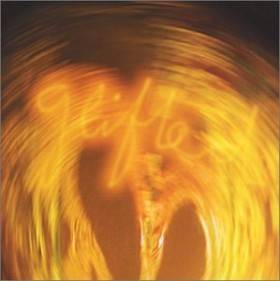 Most of the time, bands have a certain chronology: form, write songs, practice, perform, record, rinse, repeat. In the case of Glifted, arguably the greatest band that you’ve never heard from Champaign-Urbana, that list of steps was pared down to just two: write songs and record. Forming didn’t take much, as T.J. Harrison and Tim Lash had been musical mates for years prior to slapping a moniker on their project. Practicing was never in the cards either, since it’s well documented that this is one band that has never performed live. Glifted’s one and only album, Under and In, holds a couple of distinctions. First, it’s one of the only albums outside of the hip hop genre to utilize samples and loop them over and over. Second, the samples and beats were all original recordings made by the band. The results are mesmerizing. This album doesn’t just sound revolutionary; it absolutely is revolutionary — an amazing pop record strapped in a straight jacket and put on display, simultaneously enthralling and confusing.
Most of the time, bands have a certain chronology: form, write songs, practice, perform, record, rinse, repeat. In the case of Glifted, arguably the greatest band that you’ve never heard from Champaign-Urbana, that list of steps was pared down to just two: write songs and record. Forming didn’t take much, as T.J. Harrison and Tim Lash had been musical mates for years prior to slapping a moniker on their project. Practicing was never in the cards either, since it’s well documented that this is one band that has never performed live. Glifted’s one and only album, Under and In, holds a couple of distinctions. First, it’s one of the only albums outside of the hip hop genre to utilize samples and loop them over and over. Second, the samples and beats were all original recordings made by the band. The results are mesmerizing. This album doesn’t just sound revolutionary; it absolutely is revolutionary — an amazing pop record strapped in a straight jacket and put on display, simultaneously enthralling and confusing.
Perhaps it was that combination of distinctions that led the most relevant online music magazine, Pitchfork, to give Under and In the highest marks that it has ever granted a C-U artist. Not that it matters all that much, but had Pitchfork been handing out “Best New Music” labels in 2002, this record would have received it. And had Glifted been an active touring artist, you might hear their name today in the same breath as Broken Social Scene, Arcade Fire, Animal Collective, and the like. Glifted truly deserves the accolades it received. –SETH FEIN
3. Absinthe Blind
Rings
(Mud, 2003)
Listen to “The Dreamers Song” by Absinthe Blind
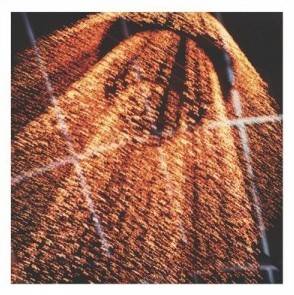 Absinthe Blind took the concept of roots farther than any band in C-U’s music community. Most of its members, from the band’s start as a group of (mostly) high schoolers to its end, grew up in C-U. And by the band’s final tour, three of its five members were family — siblings Adam, Seth, and Erin Fein. The Feins’ parents, Vern and Ilyse, rarely — if ever — missed one of the band’s gigs. Finally, the band itself was a conflation of two existing acts, The Dr. Johanson Band and Absinthe Blind. Like many bands with careers whose lengths outlast Absinthe Blind’s, there is a functional arc to this story — a band whose sound developed and matured throughout its years as the members themselves did.
Absinthe Blind took the concept of roots farther than any band in C-U’s music community. Most of its members, from the band’s start as a group of (mostly) high schoolers to its end, grew up in C-U. And by the band’s final tour, three of its five members were family — siblings Adam, Seth, and Erin Fein. The Feins’ parents, Vern and Ilyse, rarely — if ever — missed one of the band’s gigs. Finally, the band itself was a conflation of two existing acts, The Dr. Johanson Band and Absinthe Blind. Like many bands with careers whose lengths outlast Absinthe Blind’s, there is a functional arc to this story — a band whose sound developed and matured throughout its years as the members themselves did.
The final Absinthe Blind record is, appropriately, its most complete, and as such Rings acts as a perfect finale for one of the brightest, most eclectic bands to ever emerge from C-U’s loaded bench. Drenched in influence from the dark side of the ’80s — Absinthe Blind’s members are outwardly adamant about their love of Tears For Fears — and a blanket of brilliant sonic manipulation, Rings is a document of the band pushing its staple shoegazing sound to an appropriate crescendo before its exit. Rings simply soars from beginning to end. Though Adam Fein’s distinct voice is clearly the centerpiece, the record also represents the band’s greatest accomplishment in group aesthetic: no song is complete without all its elements and everything is in its right place. Full of effectively stimulating washes and astute programming, littered with emotional rises and falls, Rings may not represent Absinthe Blind at its most reckless or exploratory or extreme, but the record acts as an exceptional, self-aware synthesis of the band — breezy (“Inside My Mirror”), psychedelic (“Bands 2”), poppy (“The Dreamer’s Song,” worth a legacy in itself), gorgeous, and all with the very human potential to turn dark on a moment’s notice (see “She Saves / Now I’m Where I Need To Be,” the album’s epic penultimate track, for a one-track summary of Absinthe Blind’s creative delicacy). Rings, in many ways, finds itself elected to this list because it is the definitive Absinthe Blind.
Though Rings represents a high point for the group, Absinthe Blind disbanded in 2003 so Adam could focus on his career and starting a family. He currently makes music with C-U alum Jeff Dimpsey as Gazelle, whose record Sunblown made our honorable mention list. Absinthe Blind’s remaining members – Erin and Seth Fein, Tristan Wraight, and Brett Sanderson – eventually formed Headlights, though Seth left early in the process to pursue management, booking, and other ventures. Headlights’s three records — all of which appear on this best-of list — and tireless touring showcase how Tristan Wraight and Erin Fein have blossomed as songwriters. –ZACK ADCOCK
2. The Beauty Shop
Crisis Helpline
(Shoeshine, 2004)
Watch The Beauty Shop’s video for “Paper Hearts for Josie” and “Monster”
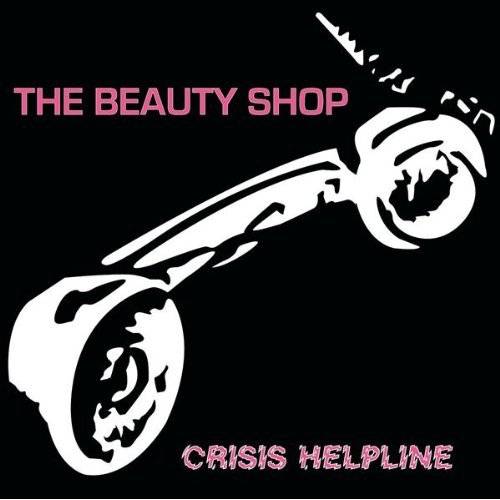 The Beauty Shop is a band whose sound rings loud and clear among the most bombastic and, at times, restrained of musical acts, and those familiar with the group will likely agree that such a statement should in no way be qualified by sequestering it as relative to C-U’s scene. The Beauty Shop’s punk-ish attitude is siphoned through acoustic instruments, sometimes even quietly, with the end result an unpredictably functional marriage between punk and alt-country. Further, second to the band’s energetic musical offerings, singer/songwriter John Hoeffleur’s willingness to both celebrate and sound off on the intricasies of life (including the music biz, local and global alike) often feels — even now — like a breath of fresh air.
The Beauty Shop is a band whose sound rings loud and clear among the most bombastic and, at times, restrained of musical acts, and those familiar with the group will likely agree that such a statement should in no way be qualified by sequestering it as relative to C-U’s scene. The Beauty Shop’s punk-ish attitude is siphoned through acoustic instruments, sometimes even quietly, with the end result an unpredictably functional marriage between punk and alt-country. Further, second to the band’s energetic musical offerings, singer/songwriter John Hoeffleur’s willingness to both celebrate and sound off on the intricasies of life (including the music biz, local and global alike) often feels — even now — like a breath of fresh air.
To hear the sometimes-wry, sometimes-wistful tone of Hoeffleur’s voice and be able to see it as a metaphor for The Beauty Shop’s overall existence is to see the tolls of rock ‘n’ roll for what they’re worth. Whether one takes joy from that voice, and therefore the metaphor itself, depends on the listener. Regardless, The Beauty Shop’s tale is not one of moral bounds or of industry evil; rather, this band proves a million cliches true — among them that hard work pays off and that quality is worth more than quantity. Point in case: though Crisis Helpline is only the band’s second (and final) album of new material in its decade on the map, few bands can attest to having put out two records as stark and honest, as brilliant and spare, as The Beauty Shop did. Crisis Helpline is full of truth and of fairy tales, both classic and contemporary (“Rumplestiltskin Lives”); of the woe of classic country music (“A Desperate Cry For Help”); and of bitter irony (“Hatchet Job”). Rock ‘n’ roll at its heart, Crisis Helpline recalls acoustic innovators like the Violent Femmes and Uncle Tupelo in its quest to allow the acoustic guitar to have its place outside of the simple “man and his guitar” dynamic, and Hoeffleur mines the difficult landscapes of personal experience and popular culture for his lyrics.
That the struggle for U.S. distribution hindered Crisis Helpline is, in some ways, important; after all, Britain’s rock ‘n’ roll powerhouse (and overall authority on all things music) Mojo favorably reviewed the band; the late, great John Peel revered the band by playing them on his show; the band successfully toured England several times; and Crisis Helpline was readily available through Shoeshine Records overseas. In a nutshell, the world was willing to notice The Beauty Shop, even if America wasn’t. Crisis Helpline‘s ranking so highly on this list despite its scarce availability in the U.S., and sometimes even locally, speaks volumes of its resonance, though. Largely a result of the band’s D.I.Y. aire, The Beauty Shop always cared more about the music and retaining its honor than it cared about big bucks. Though this attitude didn’t make them stars, it certainly contributed to the band’s placement on our list. In this way, the band’s difficulty with the business side of things is mere backstory: That the world has an album at once so innovative and traditional, and that C-U can claim to be involved with the inherently complex roots of the band that made it, are the facts more worth celebrating.
The Beauty Shop’s catalog can still be pieced together digitally. Crisis Helpline and the band’s two posthumous collections of demos can be found on iTunes, while these and other recordings can also be found on SnoCap via the band’s MySpace page. –ZACK ADCOCK
1. The Blackouts
Living in Blue
(Lucid, 2004)
Listen to “Where It Begins” by The Blackouts
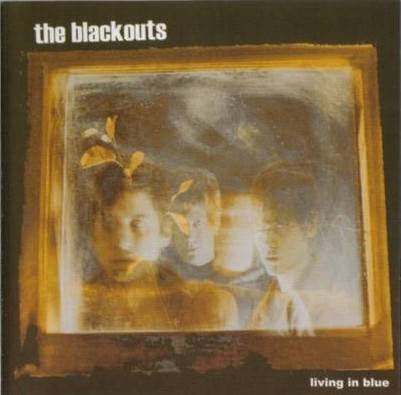 The first time I saw The Blackouts they were playing a summer gig in the beer garden of Mike & Molly’s in 2000. To put it bluntly, they were lousy. The band was a trio then: Joe Prokop and Steve Ucherek were both playing guitar (there was no bassist), Ben Ucherek was playing drums, and Prokop was doing most of the singing. The Cramps’ influence was too obvious and The Blackouts’ unimaginative interpretation of surf punk caused my friend in tow to wonder if they had prematurely stepped out of the garage.
The first time I saw The Blackouts they were playing a summer gig in the beer garden of Mike & Molly’s in 2000. To put it bluntly, they were lousy. The band was a trio then: Joe Prokop and Steve Ucherek were both playing guitar (there was no bassist), Ben Ucherek was playing drums, and Prokop was doing most of the singing. The Cramps’ influence was too obvious and The Blackouts’ unimaginative interpretation of surf punk caused my friend in tow to wonder if they had prematurely stepped out of the garage.
Still, I was intrigued. Here was a band clearly not influenced by the luminaries of the local scene. The fact that the band I witnessed on that balmy night would in five years give us Living in Blue, the consensus pick for best local album of the decade by both Smile Politely and the musical congregation we polled, was not a miracle or dumb luck. More than any C-U band of this decade, The Blackouts were the poster boys for hard work and perseverance. They put in the time to hone their inspirations — equal parts Nuggets garage psychedelia and SST punk — into a sound both distinct and gripping. The benefits for all that work were forthcoming: shortly after Living in Blue’s release, the band parlayed the album’s commercial potential into a deal with Chicago indie Minty Fresh, who had already worked with The Cardigans, Ivy, and Veruca Salt.
In the spring of 2005, I gave The Blackouts, who had just changed their name to The Living Blue, their first taste of national press when I interviewed them for Skyscraper magazine. Re-reading that article, I stumbled upon the since-forgotten detail that the band had just taken home the top prize in Little Steven’s Battle of the Unsigned Garage Rock Bands, which in hindsight sounds like the sort of event Hot Topic would have tripped over itself to sponsor. But at the time Little Stevie Van Zandt was helping The Strokes and The Hives bring garage rock back from the dead, and the win netted the band a splinter of airtime on MTV2 and a guest spot on Little Steven’s reunion of graying rock stars, where The Blackouts held down the under-thirty portion of a bill in striking contrast to performers like The Electric Prunes, Iggy Pop, and Bo Diddley.
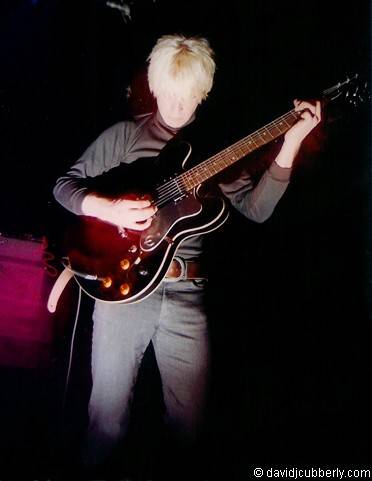 I don’t hesitate one bit in saying that “Where It Begins,” track nine on Living in Blue, is one of the best rock songs proffered by the C-U community. In the song’s extended instrumental intro you get a real sense for Prokop’s imaginative lead guitar. He mentions in the Skyscraper article being inspired as a guitarist by Strawberry Alarm Clock, the Amboy Dukes, and Nancy Wilson. That scattershot grouping hints at the eccentric style Prokop (pictured right; photo by David Cubberly) developed: from acrobatic finger tapping high on the fret; to heavy, fuzz-laden blues leads; to intricately picked Byrdsian passages; to choked, a-melodic noise. The diminutive blond was a rebellious guitar player who also happened to look great in a pair of Beatle boots and women’s jeans. The notes Prokop hammered out on the neck of his hollow-body Epiphone Dot — a guitar so large it threatened to dwarf him — were unlike anything else being committed to amplifier.
I don’t hesitate one bit in saying that “Where It Begins,” track nine on Living in Blue, is one of the best rock songs proffered by the C-U community. In the song’s extended instrumental intro you get a real sense for Prokop’s imaginative lead guitar. He mentions in the Skyscraper article being inspired as a guitarist by Strawberry Alarm Clock, the Amboy Dukes, and Nancy Wilson. That scattershot grouping hints at the eccentric style Prokop (pictured right; photo by David Cubberly) developed: from acrobatic finger tapping high on the fret; to heavy, fuzz-laden blues leads; to intricately picked Byrdsian passages; to choked, a-melodic noise. The diminutive blond was a rebellious guitar player who also happened to look great in a pair of Beatle boots and women’s jeans. The notes Prokop hammered out on the neck of his hollow-body Epiphone Dot — a guitar so large it threatened to dwarf him — were unlike anything else being committed to amplifier.
More than a minute into “Where It Begins,” after we’ve been courted by the verse’s head-banging riff, Ucherek finally chimes in on vocals: “I’ve got this notion, babe, and I can feel it. I can leave this behind. Cause I got my own two hands and I can use them. [This is] a song for those who never tried.” Ucherek had become The Blackouts’ lead singer during the recording of the band’s first album, when Matt Talbott, who recorded the group’s debut in 2002, made the correct observation that maybe Ucherek should be given a shot to sing lead all the time. He sounded a bit unsure of himself at the start, but by the recording of Living in Blue Ucherek was channeling his inner Tom Verlaine to great results. His voice now oozed personality and confidence, so when he sang “don’t throw your lives away” on the uplifiting, anthemic chorus of “Where It Begins,” your knees buckled just a bit under the weight of the words. In their lyrics, Ucherek and Prokop remained transfixed on themes of escapism — probably not too surprising for kids who grew up in a tiny outpost, Odell, along Interstate 55.
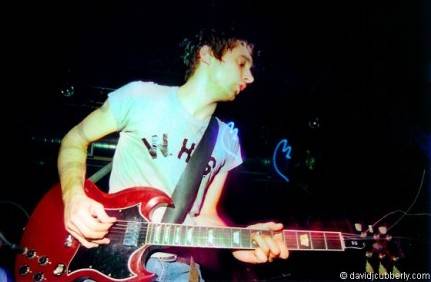 The Television reference works overtime for The Blackouts thanks to the complementary guitar interplay between Ucherek (pictured left; photo by David Cubberly) and Prokop, captured in raw, visceral form on this recording by engineer Adam Schmitt. Ucherek’s rhythm playing was typically bluesy and lax, while Prokop provided a muscular, sometimes serrated melody over the top. The rhythm section was proficient yet loose. Drummer Mark Schroder was a cornerstone of the band for many years, always pounding away on his drums with a cigarette drooping from his lips. The revolving door of bassists settled on Pat Olsen for this record, and the young’un played a tuneful low end, as evidenced by his opening salvo on “The Games That Play Us.” (Shortly after the recording of Living in Blue, he left the group and was replaced by Andrew Davidson.) As with all great bands, the collective musical whole was greater than its parts, more than making up for any deficiencies on a given night.
The Television reference works overtime for The Blackouts thanks to the complementary guitar interplay between Ucherek (pictured left; photo by David Cubberly) and Prokop, captured in raw, visceral form on this recording by engineer Adam Schmitt. Ucherek’s rhythm playing was typically bluesy and lax, while Prokop provided a muscular, sometimes serrated melody over the top. The rhythm section was proficient yet loose. Drummer Mark Schroder was a cornerstone of the band for many years, always pounding away on his drums with a cigarette drooping from his lips. The revolving door of bassists settled on Pat Olsen for this record, and the young’un played a tuneful low end, as evidenced by his opening salvo on “The Games That Play Us.” (Shortly after the recording of Living in Blue, he left the group and was replaced by Andrew Davidson.) As with all great bands, the collective musical whole was greater than its parts, more than making up for any deficiencies on a given night.
The Blackouts were a true success story of the decade’s scene: a crummy, outsider band who went from playing to their girlfriends, to packing medium-sized venues on a Friday night, to signing with a reputable indie and touring the States and Europe. I will always remember The Blackouts as a band who knew how to have a genuine good time both on and off stage. That stirring vibe permeated their performances and infected their fans, which aided the band as it fostered a strong sense of community. It didn’t hurt that they were also one of the scene’s most consistently engaging (and loudest) live acts: they absolutely brought it when they stepped on stage. For eight years in this decade they partied hard and walked the walk, leaving behind a haul of impassioned rock and roll songs. I believe it was the band’s immense energy and youthful yearning — the attitude of “fuck this, we can be better” — that captivated a scene hungry for change, even if it didn’t know it at the time. That’s exactly what The Blackouts gave ’em: propulsive growth in an unfamiliar direction.
Ucherek’s comment in that 2005 article was telling: “The bands that stick around are those that make music on their own terms and don’t pay attention to someone else’s expectations. We’re not trying to win friends and influence people. We’re lifers.”
Prokop’s response to Ucherek’s heartfelt statement provided me with the quote of the article: “That’s real propa.”
Indeed.
–DOUG HOEPKER
* * *
Let’s have a round of applause for all the bands who made our list. The best way to celebrate: spend a little bit of that hard-earned plastic that’s eating a hole in your wallet on their fine records. And as we turn the page on the aughts, get your pencils sharpened and begin making your list for the teens. After all, it’s never to soon to begin thinking about 2019.
* * *
Many thanks to the writers who contributed to this article.
Zack Adcock has written music reviews and commentary for the Buzz (at which he was both music editor and managing editor), The Paper, and The Hub, at which he was founding music editor. He has also been a contributing writer for PopMatters and Smile Politely. He currently lives and writes in Memphis, Tennessee.
Seth Fein is the founder of Pygmalion Music Festival, one of the talent buyers at Canopy Club, and a Smile Politely editor. He performed with the band Absinthe Blind from 1996–2003 and with Headlights in 2004.
Doug Hoepker was the music editor at The Octopus and CU Cityview, a frequent rock and roll DJ (The Noiseboy), a freelance music critic for various online and print publications, and one of the many folks who helped get WRFU off the ground. He currently is a Smile Politely contributor who frequently wonders if a “career” in publishing is even worth it any more.
Beyond paying his early dues as a Buzz stringer, Joseph Martin also drummed in one iteration of The Beauty Shop, interned at Parasol, put on shows at the IMC, wrote a comic strip for the Daily Illini, and spent a few years clerking at Record Service. He currently resides in Baltimore, Maryland.
Brian McGovern started his association with C-U music in 2005 by writing the “Buzz Pick of the Week” and went on to write the long-winded and self-indulgent music column “Spin it Round, Flip it, and Reverse it.” Most recently he was an editor for Smile Politely and drew comics about bands. Brian, who plays in World’s First Flying Machine, currently lives in Chicago and misses seeing shows at Mike ‘N Molly’s and the Canopy’s void room.
Logan Moore, a former contributer to the Buzz and current Smile Politely critic, was raised in Florida with Illinois blood. He just finished his master’s degree in library science.
Edward Moses, a music critic for Smile Politely, is an MC who goes under the moniker AMS and has been writing and recording hip hop for years.








